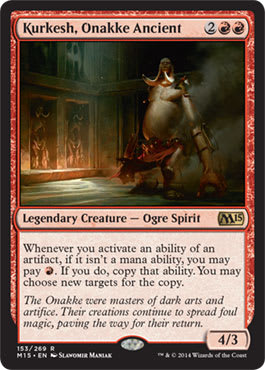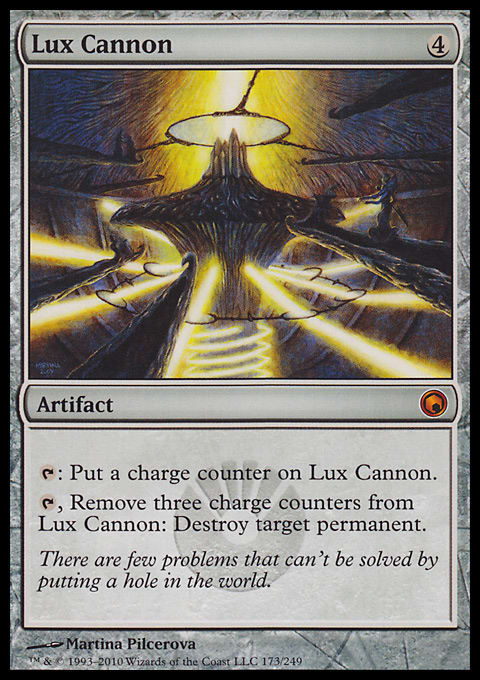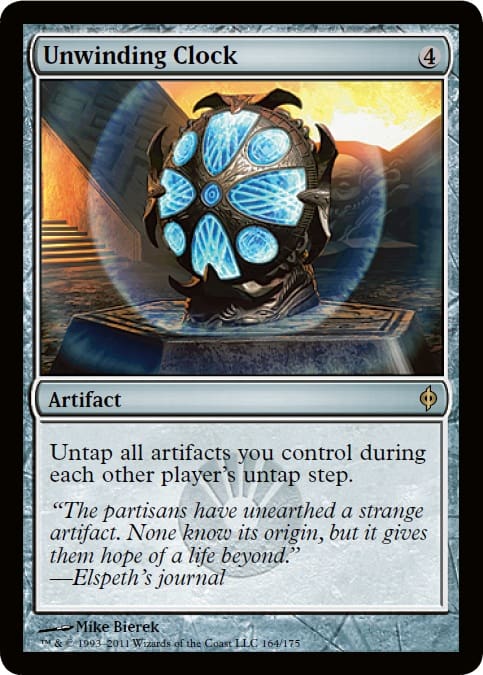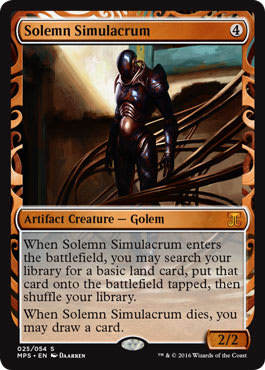I build mostly 75% decks for my own personal use. I like the flexibility it affords me, and I like going into unknown playgroups knowing that my deck is Goldilocks tuned so that I'm not likely to make anyone else or myself completely miserable. Not making anyone completely miserable is a small goal for a Commander list, but I do what I can.
75% as an ethos has helped me build decks that I can take into any situation and not have to modify, but today, I started thinking about a situation in which you might want to modify the deck. My inspiration? The Commander (2014 Edition) precons.
With the entire black Commander deck spoiled, we have a real comprehensive look at what kinds of things they're planning for every deck. I'm not going to link the list here because, frankly, I'm not a big fan of whoever leaked the whole list. They ruined spoiler season for me to an extent, and it's really unfortunate that it had to happen. Still, looking at the whole list made me think about how there is a definite theme of generating value when your creatures die and/or come back from the graveyard repeatedly and how all three of the potential commanders in the deck work with that theme. You can keep those same hundred cards intact as they come as the precon and pick a commander that fits your particular play style, and the rest of the cards in the deck will function just fine with any of the potential commanders.
I really like this concept—not only that, but I thought about the choice of commander as a way to dial in the power level of the deck. We could having a deck that would benefit from having access to a certain legendary creatures but that wouldn't be as powerful if you couldn't access them every game. I started to think about three commanders that would run in similar decks but that would have different power levels—or even just different utilities—and it occurred to me that there is an old card, a recent card, and a spoiled card that would play well in the same deck. Not only that, but you would be able to contend with different kinds of decks depending who was in the command zone. I present to you my three choices for commanders.
The deck will be functionally different, but the other ninety-seven cards will be the same depending on whom you pick for the command zone. Let's take a look at the kind of deck we'd run.
Artifact Red ? Commander | Jason Alt
- Commander (0)
- Artifact (36)
- 1 Basalt Monolith
- 1 Brittle Effigy
- 1 Caged Sun
- 1 Clock of Omens
- 1 Darksteel Forge
- 1 Darksteel Ingot
- 1 Dreamstone Hedron
- 1 Everflowing Chalice
- 1 Extraplanar Lens
- 1 Fire Diamond
- 1 Gauntlet of Power
- 1 Illusionist's Bracers
- 1 Lightning Greaves
- 1 Lux Cannon
- 1 Memory Jar
- 1 Mind's Eye
- 1 Mind Stone
- 1 Mirrorworks
- 1 Mycosynth Lattice
- 1 Myr Turbine
- 1 Nim Deathmantle
- 1 Phyrexian Processor
- 1 Planar Portal
- 1 Ring of Three Wishes
- 1 Rings of Brighthearth
- 1 Sculpting Steel
- 1 Skullclamp
- 1 Sol Ring
- 1 Spine of Ish Sah
- 1 Thran Dynamo
- 1 Titan Forge
- 1 Tower of Fortunes
- 1 Trading Post
- 1 Unwinding Clock
- 1 Voltaic Key
- 1 Worn Powerstone
- Creatures (19)
- 1 Anger
- 1 Arcbound Reclaimer
- 1 Darksteel Colossus
- 1 Duplicant
- 1 Goblin Welder
- 1 Junk Diver
- 1 Kuldotha Forgemaster
- 1 Lodestone Myr
- 1 Myr Battlesphere
- 1 Myr Retriever
- 1 Palladium Myr
- 1 Phyrexian Colossus
- 1 Scuttling Doom Engine
- 1 Shimmer Myr
- 1 Solemn Simulacrum
- 1 Steel Hellkite
- 1 Steel Overseer
- 1 Thopter Assembly
- 1 Wurmcoil Engine
- Sorceries (2)
- 1 All Is Dust
- 1 Trash for Treasure
I tried to reconcile a few different strategies as well as a few different decklists that had different ideas about what kind of permanents to run, but I think I got it. Feldon fits in very nicely to the intersection of the Kurkesh and Bosh decks despite my first—and still probably best—idea about what to do with Feldon: Play some sort of Goblins value deck. Still, Feldon doesn't care if the creature you animate is already an artifact. Think of the value you can generate with Feldon! It doesn't remove or exile the creature, it just makes a copy that sacrifices itself at the end of the turn. Imagine you're making a token that is Wurmcoil Engine or Scuttling Doom Engine! There is a lot you can do here to generate value with Feldon, and a lot of the cards already exist with either of the other two creatures as your commander. Let's look at how the same cards play a little differently with the different commanders.
Bosh
The Bosh, Iron Golem deck is very straightforward. You're aiming to put artifacts on the field and then chuck them at your opponents' domes. Attacking with Bosh is a decent clock as well, and with the artifact mana ramping to him, you can start the beats with a substantial trampler very quickly. You have some artifact durdling to do, such as adding counters to Lux Cannon or engaging in some Myr shenanigans. Your aim here is to just deal damage, so you will want to play this configuration (Bosh in the command zone, Feldon and Kurkesh in the deck) in matches in which you expect your opponents will be more casual. Your commander won't help you with your artifact shenanigans, he'll only help you reduce the size of your board presence as well as their life totals. You're going to still benefit from the way the deck is set up, and cards like Trading Post and Junk Diver and Goblin Welder will really help you Fling stuff at them repeatedly. Trash for Treasure to bring back a Scuttling Doom Engine to throw again is a lot of fun. Play this commander accordingly—this is the "fun" configuration of the deck.
Kurkesh
Here, you're less focused on attacking and more focused on the abilities of your artifacts. Copying Unwinding Clock, Clock of Omens, Lux Cannon, and the like will help you ramp up your shenanigans very quickly. Kurkesh has a solid body, but you're more worried about generating advantage with your bevy of artifact toys. Gaining double activations out of a lot of these artifacts is going to be a great way to win games. You're not all-in on this strategy, and I built accordingly, but there are still plenty of things in the deck to help you take advantage of the fact that your activations are doubled. I would say this is your midrange kind of 75% build. Maybe he should be your default commander. He'll still be a very fun card to cast if you're using one of the other two commanders, but he should be your default.
Feldon
I think the Feldon build is probably the strongest. Cards like Kuldotha Forgemaster can find you the cards you need to start creating value loops or just sick value every turn. Feldon with Solemn Simulacrum for a few turns is a good enough advantage engine, but imagine making a Wurmcoil Engine token you're "forced" to sacrifice every turn. Remember that Feldon just makes a copy—it doesn't remove the original card from the graveyard, leaving you free to loop Doom Engine or Wurmcoil or even Burnished Hart if you find room for one of those. I would say this is the configuration you want if you're aiming for a stronger opponent!
There you have it. I took a page out of the precon's book and came up with a deck that scales based on which of your potential commanders is at the helm. This brainchild was the result of an entire day of writer’s block, but it was worth it in the end. I may do another one of these with three more commanders if you all want. So, which card was an obvious card I missed, something that is killer in all three decks or so good in one configuration it's worth having in the other two? Leave it below in the comments section!
As always, I rely on you, my readers, to keep me on track. Remember that the 75% ethos is a set of guardrails on the highway, not a policy that gives out tickets if you don't wear a seatbelt. I'm here to give you some guidance on how to build a deck that will never sit in your backpack if you don't want it to and to help you interact with new playgroups. Let me know how your 75% decks are working out for you, and tune in next week for more value.






























